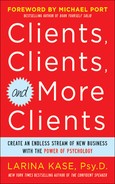Who Are We Most Influenced By?
,While we are influenced by those around us, social proof, also called social norms, is particularly powerful when we see the other people as similar to ourselves. In 1954, social psychologist Leon Festinger came up with social comparison theory, which states that we evaluate ourselves by comparing ourselves to people who have similar characteristics to our own.
We can’t help but to compare ourselves to others and be influenced by those comparisons. When I walk my dogs down my street and see my neighbors’ yards looking beautiful, I feel compelled to work on my own yard. On the other hand, when I’m out in California visiting my sister and I see her neighbors’ yards looking beautiful, I appreciate them but do not compare them to my own yard or feel as strongly compelled to work on my yard.
I always ask new clients why now is the time that they want to grow their businesses. A new client recently told me, “I got together with some friends from my grad school class and they all have successful practices, so I thought, there’s no reason I shouldn’t have a more successful practice.” She’s right.
Guests at your hotel
Noted researcher on influence Robert Cialdini and his colleagues Noah Goldstein and Vladas Griskevicius set out to discover exactly how social proof and similarity work. They conducted a fascinating study of hotel room guests to see what type of signs in hotel rooms would most influence guests to reuse their towels and help the environment. The first sign included a message commonly used in hotel rooms that stated how reusing towels helps the environment:
HELP SAVE THE ENVIRONMENT. You can show your respect for nature and help save the environment by reusing your towels during your stay.
The second sign included a social norm statement:
JOIN YOUR FELLOW GUESTS IN HELPING TO SAVE THE ENVIRONMENT. Almost 75% of guests who are asked to participate in our new resource savings program do help by using their towels more than once. You can join your fellow guests in this program to help save the environment by reusing your towels during your stay.
Data were collected in 190 rooms with guests staying at least two nights over 80 days in a midpriced national chain hotel located in the Southwest. The room attendants checked whether guests opted to reuse a towel (by hanging it on a towel rack) versus getting a new one (by leaving the used towel on the floor).
Results showed that people with the social norm statement reused their towel 44 percent more than those with the environmental statement only, an amount much greater than the average towel reuse programs received. This number may even be an underestimate because data were collected only on guests’ first eligible day, and the measurement standards were quite strict (e.g., the researchers didn’t count towels hung on doorknobs, only on the towel rack). This compelling data highlight how strongly we are influenced by what others do, even when those people have only broad similarities to us, such as being other guests in a hotel.
Guests in the same room of your hotel
These researchers then conducted a modified version of their hotel room study. Because people tend to follow the norms that match their own situations, Goldstein, Cialdini, and Griskevicius theorized that including a social norm statement about the hotel room’s previous guests would lead to an even higher rate of towel reuse.
This time they tested five messages:
1. The same as the message on page 139 about general environmental benefit (no social norm).
2. A message about 75 percent of other hotel guests (general social norm).
3. A message that used people who had stayed in the same room as the social comparison group, stating that 75 percent of the guests in that particular room had reused towels.
4. A message that used fellow citizens as the social norm, stating “Join your fellow citizens …”
5. A message that specified gender, stating that 76 percent of the women and 74 percent of the men reused their towels.
As the researchers predicted, all of the social norm messages (#2–4) resulted in significantly more towel reuse than the standard environmental message (#1). The message that resulted in the most towel reuse was the similarity message (#3) about people in the same room. This one was statistically higher than the other three (#2, #4, and #5), which were statistically equal to one another.
I would not necessarily think of people who share my same hotel room as being similar to me, but remember that people who share a similar situation or circumstance are a powerful source of social comparison. The more similar the comparison group, the more powerful the influence.
Similarities and your target audience
Your description of current clients should fit with new clients’ perceptions of themselves. Remember that people identify strongly with those who are in a similar situation or circumstance to themselves, which can even be as simple as the guests who stayed before you in your hotel room.
When you have a solid understanding of your audience and how they are similar to one another, you can show your understanding of them and use social proof to influence them to hire you or refer to you.
Complete the action steps that follow to ascertain ways in which your target audiences of clients or referral partners are similar to one another, and in the next step we’ll explore ways to use social proof in your marketing.
The great thing about social proof is that you can use it to create a positive cycle of influence. You use social proof to attract new clients. You then use social proof to enhance the results and benefits your clients receive. You then use social proof from all your great results to attract additional clients and referrals.

